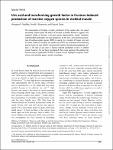| dc.contributor.author | Madlala, Hlengiwe P. | |
| dc.contributor.author | Maarman, Gerald J. | |
| dc.contributor.author | Ojuka, Edward | |
| dc.date.accessioned | 2023-01-20T07:02:44Z | |
| dc.date.available | 2023-01-20T07:02:44Z | |
| dc.date.issued | 2016 | |
| dc.identifier.citation | Madlala, H. P., Maarman, G. J., & Ojuka, E. (2016). Uric acid and transforming growth factor in fructose-induced production of reactive oxygen species in skeletal muscle. Nutrition reviews, 74(4), 259-266. | en_US |
| dc.identifier.uri | doi: 10.1093/nutrit/nuv111 | |
| dc.identifier.uri | http://ir.lirauni.ac.ug/xmlui/handle/123456789/485 | |
| dc.description.abstract | The consumption of fructose, a major constituent of the modern diet, has raised
increasing concern about the effects of fructose on health. Research suggests that
excessive intake of fructose (>50 g/d) causes hyperuricemia, insulin resistance,
mitochondrial dysfunction, de novo lipogenesis by the liver, and increased production
of reactive oxygen species (ROS) in muscle. In a number of tissues, uric acid
has been shown to stimulate the production of ROS via activation of transforming
growth factor b1 and NADPH (nicotinamide adenine dinucleotide phosphate) oxidase
4. The role of uric acid in fructose-induced production of ROS in skeletal
muscle, however, has not been investigated. This review examines the evidence for
fructose-induced production of ROS in skeletal muscle, highlights proposed mechanisms,
and identifies gaps in current knowledge. | en_US |
| dc.language.iso | en | en_US |
| dc.publisher | Oxford University Press | en_US |
| dc.subject | fructose, mitochondrial dysfunction, reactive oxygen species, transforming growth factor, uric acid. | en_US |
| dc.title | Uric acid and transforming growth factor in fructose-induced production of reactive oxygen species in skeletal muscle | en_US |
| dc.type | Article | en_US |

